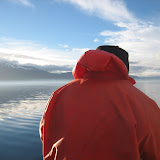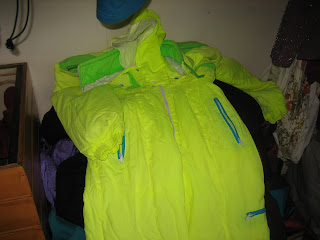
Tuesday, June 30, 2009
Travelogue: Hitching

Friday, June 19, 2009
Travelogue: Sailing
Thursday, June 18, 2009
Photos: Carretera Austral, Tierra del Fuego, Isla Navarino
Photos from the last three weeks. As always, over-captioned for your enjoyment.
 |
| Carretera Austral,Tierra del Fuego, and Isla Navarino |
If that doesn't work try: http://picasaweb.google.com/JSant27/CarreteraAustralTierraDelFuegoAndIslaNavarino?feat=directlink
Monday, June 8, 2009
Re: The Docks
I went back to the Docks yesterday and found the mysterious Dutchman with the beautiful sailboat. After a brief chat, Bart agreed to give me a ride to Puerto Williams, 5 hours across the Beagle Channel. The trip usually costs $100 for a 20 minutes ride on a small Zodiac motorboat, so I'm pretty proud of having secured such a superior alternative. Furthermore, due to Chilean territorial ambitions and the arbitrary nature of political boundaries, Puerto Willliams is actually part of Chile's Antarctic claim. Thus, assuming all goes to plan, on Thursday I will be able to claim having visited all 7 continents (although there will be an asterisk by my name due to the tecnhicality).
Sunday, June 7, 2009
Cultural Connections: All your 80s ski wear
Every Southern Chilean town, no matter how small, has at least one shop that sells "Ropa Americana." These second-hand clothes come by boat from the United States and Canada and are bought up by enterprising merchants throughout Chilean Patagonia. By the looks of the merchandise, an enterprising exporter in the U.S. or Canadaa buys up a quantity of clothing and then lets it "age" before releasing it to Chilean importers. Right now, the 1985-1988 vintage is hot.
Chile is home to several super ski resorts, but few of them are in Patagonia. When it comes to being warm, however, style matters little in this part of the world. Consequently, what would only pass for ski clothing in the U.S. is everyday wear during frigid Chilean winters.
I am primarily talking ski bibs. At some point 10-15 years ago, savvy American skiiers decided that a bib with suspender straps was no longer either necessary or acceptable. Discovery of the magic of elastic, and the modernization of ski jackets to include advanced features such as powder skirts, ushered in an era of fancy ski "pants" with all sorts of nooks and crannies built-in. A sea change also took place in terms of colors. Bibs had been available in a veritable neon rainbow of colors, but the era of pants has been dark hued.
The World's carpet littered with bibs, Chile stepped in to vacuum. If you can handle the color, there are deals to be had. Having sifted through bins and racks and more bins and racks of neon green and fuschia, I am convinced that we made a mistake. The only thing that has stopped me from buying 13 neon ski bibs (most with polyster inlaid somewhere) is the size of my bag. These bibs are national treasures, and I plan to start a business exporting the imports back to the U.S. Note the superman suit below, one of my personal favorites.


Saturday, June 6, 2009
The Docks
Greg is from Vancouver, but left five years ago to sail around the world. He looks about 65. He told me he bought his first sailboat before I was born, and is on his third. His wife is with him for a couple of months but will return to Canada in August. I asked him if I could hitch a ride to Puerto Williams, a Chilean settlement that is the actual Southernmost town in the world. Trying to be polite but trying to say no, he explained that there is not much space and if the weather is bad he may have to anchor somewhere for several days, in which case I would be stuck with them. "I can handle that," I said desperately. "Well," he stuttered, "what I really mean is we would be stuck with you."
No hard feelings, we continued chatting for a while. He had crossed the Pacific Ocean from French Polynesia to Chile and is now rounding the Southern tip on his way to the Falkland Islands and then up to Buenos Aires to have some repairs done. I was curious about Antarctica seeing how Ushuaia is fewer than 700 miles from the polar continent. "In my younger days I was ballsy," he explained, "but now I'm more careful and the ice just makes me nervous."
I was at the docks with some fellow travelers, Enrico and Casey, looking for a cheaper alternative to the sightseeing trips that take tourists around the Channel. The city has a dock where people can pay to anchor as they pass through. The "club" also has a kitchen, bathrooms, and lounge facilities. We found a man on shore who said to just go ask around the boats. Somehow feeling that we were trespassing, we tiptoed onto the docks, marveling at the array of sailboats. Some were old and basic, some were new and fancy, but all gave the impression that they had known wondrous voyages.
After our chat, Greg told me to check with a Dutchman moored nearby, who has a large, beautiful sailboat all to himself. To get to the boat I had to walk on another. It belongs to a French guy and is chartered for 25 day trips to Antarctica. After a few timid attempts at "hello?", I decided nobody was home and skittered back to the dock.
We spoke with a local man who keeps a small sailboat at the club. We told him we wanted to just take a spin around the channel, maybe see the local penguin colony. He pulled on his cigarette, looking a bit disgusted by our ignorance and a bit confused as to why we did not just go to the tourist agency. "There aren't any penguins," he said, squinting through his own smoke. He lightened up after that with some joke about how they didn't like the cold, and suggested we ask Mickey, who goes to Puerto Williams and Cape Horn.
We couldn't find Mickey, so we took our by then well-practiced query to a sailor on one of the tourist boats. He had a perfectly formed, silver handlebar moustache and hunched down in his coat as he smoked. Openly pessimistic about our prospects, he pulled out a cellphone, saying he knew of one person that might help us. Phone to his ear, we saw his eyes light up as the line connected. "Mickey?!" we heard him say.
After some hefty laughs, a brief explanation of our situation, and friendly banter we didn't understand, he passed the phone to Enrico. Enrico told him we had heard he might be going to Cape Horn and that we would love to come along if possible. Casey and I listened with glee as we heard Enrico answer that, yes, we did have raingear, warm clothing, and shoes. We were convinced we had just scored a free trip to Cape Horn--surely such details would only be discussed at the conclusion of a successful call. Then we heard Enrico say "1500 dollars?" and sank back to Earth.
The captain of the Antarctic-bound charter boat, a French expat, emerged at that point, and I asked him if he knew anyone going to Puerto Williams. "This is a really bad time," he explained, with a touch of condescension. "There are not many people going and you may get stuck." After a bit of an awkward conversation in which he presented problems which I insisted didn't bother me, he suggested I call Wolf, who would be going in a few days. Thrilled, I waited giddily for the number and off we went. Wolf's wife Jeanette was lovely on the phone as she explained that yes Wolf would be going soon and could take me, but that he might stay for a week. "No problem," I answered. She went on to mention that the cost would be $100 each way. Too expensive, another defeat.
Our mission, though unsuccessful in terms of finding a cheap excursion, was nevertheless encouraging. What I learned is that private boats come in and out of the docks going in all directions, and that most of the sailors are happy to talk with visitors. People like Greg, for example, are also travelers and are not out to gouge anyone. I am convinced that, if I keep trying, I'll meet someone looking for help or even just company. If I do meet that person, regardless of where the boat is going, I'm getting on.
People: The Cyclists
Ushuaia, because of its generally accepted status as "Southernmost City in the World," attracts travelers with pretty amazing itineraries. I have met two cyclists here whose trips blew my mind:
Daniel is about 40 years old, from the province of Buenos Aires, and works in the family business selling bicycle equipment. He is going to bicycle all the way from Ushuaia to the Northern reaches of Alaska on a trip that will last more than one year, and has been ten years in the planning. His budget is 25000 pesos, which comes to about 6,600 USD. He also spent about 15000 pesos on his gear (about 4000 USD), which includes a bike, a trailer, and good camping gear. In 2001 he cycled the whole of Argentina, from North to South, but his family thinks he is too old for this trip.
Jaffie is 24 and from Nepal. A UCLA graduate in Anthropology, he has spent the past 20 months cycling through the Americas. He ran out of money in Ecuador, and has since earned money writing the occasional travel article, working odd jobs, or selling musical equipment he left back home. A girl in Costa Rica pitied him after he was robbed and he ended up staying in her house for a month. A police officer in Bolivia helped him cross the border illegally to avoid paying a visa fee.
Having seen the mania that is the Central American highways, I asked them if they feared getting hit. Both downplayed the danger and have covered thousands and thousands of accident-free kilometers. Daniel uses a small mirror to monitor oncoming traffic. Jaffie pointed out that on long stretches of road in Latin America, most of the traffic is commercial trucks with professional drivers.
Tuesday, June 2, 2009
Los Antiguos Border Crossing
The border towns of Chile Chico (Chile) and Los Antiguous (Argentina) face off somewhere between Northern and Southern Patagonia. Both have beautiful surroundings and small town charm, but serve mainly as gateway cities. I spent a lovely evening in Chile Chico, chatting with the senora of the hospedaje, a city councilwoman and ardent socialist, before boarding a morning mini-bus for Los Antiguos. On the way I chatted with a local guy who was crossing over to shop for flour and other supplies in Argentina--its much cheaper there. He asked about typical salaries in the U.S., the cost of my North Face jacket, and, with a look that said he would be very sensitive to my answer, my opinion of Chile. I evaded the last question, explaining that much of my time in Chile had been on the "campo" with foreigners.
Chile bid me adieu with no problems. Argentina stamped me through and bid me good trip. As I walked back to the mini-bus, however, the driver called me back.
"Oye," he called. "There is a new woman here who wants to check your bag. Usually they don't ask but she's new..."
"No problem," I said, hefting my backpack, which is by now a delicately packed behemoth, into the customs office. I had a few apples and a cucumber and said so immediately, not wanting to appear evasive and knowing they would not be allowed. Head's shook: "We have a plague of apples right now." Oops. Argentina, unlike Chile, does not fine for such indiscretion, but they certainly wag their fingers at you.
The real problem was the pills. My dopkit is full of them. When I left I took about 60 ibuprofen out of a large bottle and put them in a clear ziplock. I didn't anticipate a problem but now it is clear to me why it might not be a great idea. This anonymous, suspicious baggie full of Argentina-knows-what lent a certain suspiciousness to everything else: the bottle of tylenol, the ziplock full of antibiotics, the generic Mexican stomach meds, the multi-vitamins! That and sheer quantity. Several times I heard other guards ask the bag-searcher how many pills I had, obviously implying that if there were few, it would not be a problem. Her pained response, after a sigh, was "there are lots."
These two poor customs women, I'll call them Stickler and Amenable, were flummoxed. Pills abound and no way to identify them, and now a smug backpacker on his way to irate, indignant that his well-traveled pills would meet their fate in this forgotten backwater of a border town. I insisted that I was not parting with anything unless they could show me the written law. Amenable seemed to understand my displeasure and sought to ameliorate it, calling other offices for clarification on the rules and advice on this situation.
Meanwhile Stickler proceeded to dismantle the whole of my luggage. She held at arms length, pinched between the tips of cautious, condescending fingers, my collection of plastic baggies, my scraps of newspaper, my pieces of string, my packets of soup, my Argentine Playboy magazine (traded for my last New Yorker in a hostel, but just for language practice). I curtly identified each item, lingering close, exuding distrust.
My driver had already left once to take the other passengers across the border and returned to get me when I realized I had been at this border station for almost 2 hours. While Stickler insisted that I could not bring any medicine into the country Amenable was attempting to identify the mystery pills. There seemed to be a lack of agreement in policy. Despite the initial statement that transporting meds was not allowed, full stop, they were allowing me to keep the seemingly more "heavy" amoxicillin. Also, despite their contention that the ibuprofen was a problem because it was "loose" and unidentifiable, they did not have a problem with the open bottles of Tylenol and vitamins, nor with the several blue Advil PM (if anything the most dangerous of all) floating loosely in the dopkit itself.
Seeing the hour, I pleaded, although not desperately, that I did not have time, that I had a bus to catch and did not want to hold my driver any longer. Still, I had to wait. I realized that Amenable was trying to form a collective identity between us all, trying to foster a sense that all of us in that amateurish border station were in it together against the larger Argentine bureaucracy. I wasn't having that bullshit and maintained my emotional distance. She said we had to wait for a call from some other office, and offered me a smoke in the meantime. I coldly refused.
The much anticipated phone call was of no help, and at this point ouAmenable informed me, with complete apology, that she was going to the local hospital to see if they could identify the pills. I threw up my hands and almost screamed, completely amazed at the ridiculousness of the situation, and tried once more to say, I give up, let's pretend I never protested and you can have all my pills. "I can't," she lamented, "now we have to find out what this is."
I knew the driver was losing money--all he does is go back and forth with border-crossing passengers all day at frequent intervals--so I told him he could leave. He accepted my offer, kindly explaining how I could walk across the border and into Los Antiguos, and then, ever so sheepishly, told me he still had to charge me. "It wasn't my fault," he said with a shrug and some sort of squishing up of his face that was meant to convey sympathy. He had been nice to wait this long, but I was still a bit hurt by the desertion.
Amenable came back from the hospital with no luck and said they had to keep trying. Stickler sat at her computer, having been silent for quite some time. I could tell she felt bad about having launched this fool's crusade and, to augment her regret, I subtly played the part of dejected and persecuted innocent, far from home and all alone in an unforgiving place.
In fact, the place was supremely pleasant, and if I had to be stuck at a border crossing I could have done worse. Warm, with beautiful views of the Patagonian steppes through plentiful windows, I was quite comfortable and did not at all feel threatened. Having made my traveler's rights stand and having tired of doing so, I decided to read my book and wait it out in peace. Thirty minutes later my allied official waved me outside and said, "ok, we're done." When I asked what had changed she answered "nothing." She explained that they still could not identify the pills, but neither could they continue to hold me.
To top off the weirdness of it all, she offered me a ride to town in the customs department car, which I heartily accepted. She explained the recent problems they had been having with drugs, I explained that, traveling for an extended period of time, I had to be vigilant about my stuff. She said sorry, I said sorry, we chatted about this and that, I made it in time for the next bus South. I lost two apples, a cucumber, and more than 60 ibuprofens. Having made it across with the rest, I call it a victory.
Photos: Cagalandia
This is a well-captioned set of photos that should explain a lot about the "farm" I worked on in Chile.
http://picasaweb.google.com/JSant27/2009TravelsCagalandia#








